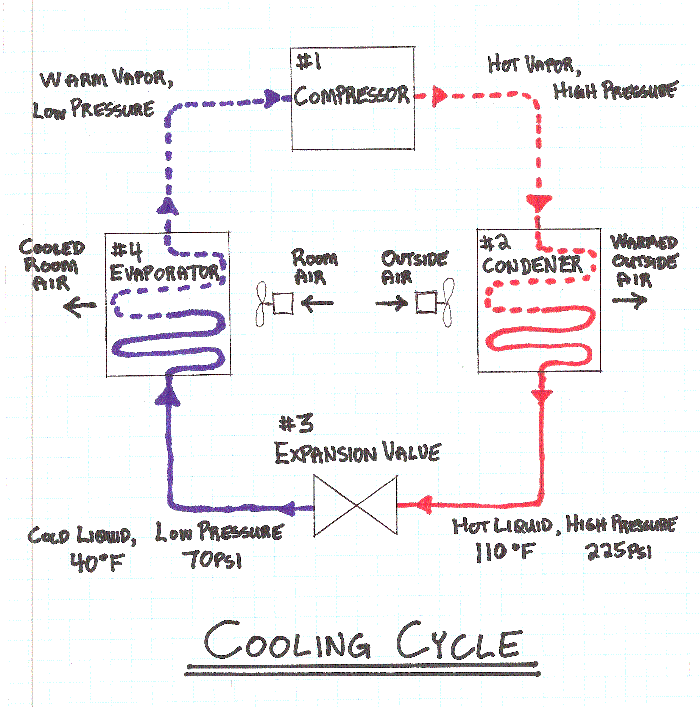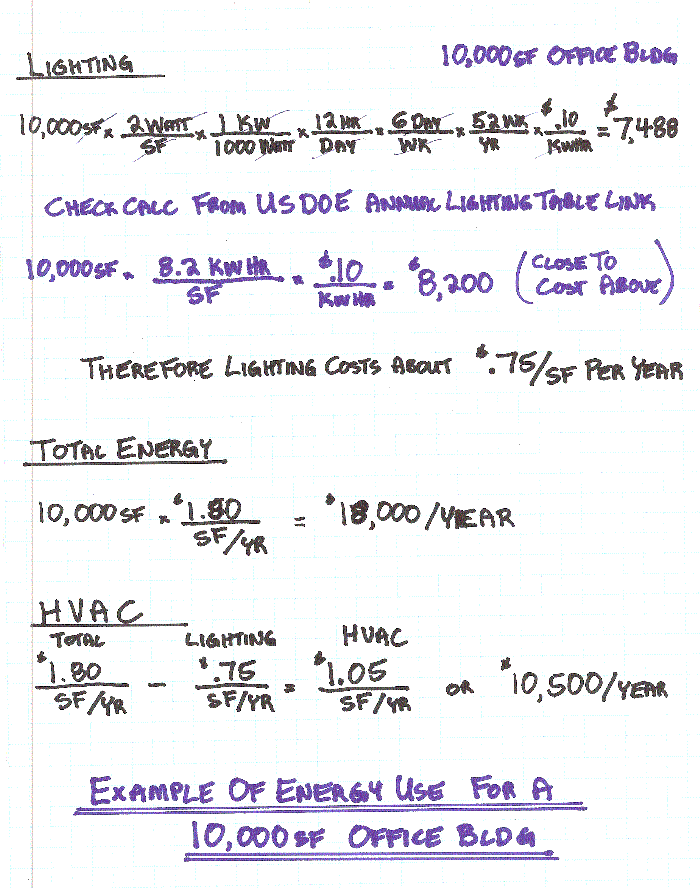 CONSTRUCTION KNOWLEDGE >>
MECHANICAL >>
CONSTRUCTION KNOWLEDGE >>
MECHANICAL >>
HVAC
1. How Can I Begin to Understand HVAC Systems?
2. What are the Basic Types of HVAC Systems?
3. How Does Air Distribution Work?
4. What Should I Know about Rough Sizing Systems?
5. What Should I Know about HVAC Energy Usage?
6. What Public Domain Documents are Available for Further Study?
7. Tricks of the Trade & Rules of Thumb for HVAC Basics:
How Can I Begin to Understand HVAC Systems?
The heating, ventilating and air conditioning (HVAC) systems drive occupant comfort in buildings. HVAC systems control the air temperature, of course, but also to intake outside air, exhaust or filter contaminated air and efficiently use energy. Since HVAC systems are complicated, many Construction Supervisors don't bother to learn about them. That's a mistake. Most of the occupant complaints about the buildings we build involve HVAC systems, so we should all be paying more attention to how these systems get designed and installed.
If you take the time to understand the basics of HVAC systems, you'll discover valuable knowledge that you'll use on every project. Start by watching these well done training videos by Price which show the Basics of HVAC.
Another excellent Price training video is
Comfort Criteria, which explains how occupants actually experience
the HVAC system in action.
![]()
What are the Basic Types of HVAC Systems?
Whenever you consider an HVAC system, begin with a few basic questions.
- What is the fuel used for heating? Gas, oil, coal, electricity, etc.
- What is the type of cooling? Electric heat pump, electric air conditioner, chiller, gas air conditioner, etc.
- How is the heat or cooling delivered to the occupant space? Hot and cold ducted air system, hot and cold water system (hydronic or steam), radiant heat system, etc.
- What is the ventilation? Summer ventilation with intake louvers and
fans, supply and return air with outside air introduced for ventilation,
dedicated ventilation system, etc.
Unfortunately, answering the questions above doesn't lead you right into understanding the HVAC system because of the many options. Answering the questions above puts you on the right track for beginning to understand the system, though. The next step is to know about a few basic systems and recognize a common HVAC system when you see it.
For the rest of this section, I'll describe a few HVAC systems that you may encounter on the jobsite. Understanding the basics of how the system works will help you to understand more later. The first thing that you need to understand with almost any HVAC system is the basics of air conditioning. The sketch below explains the air conditioning cycle.

To understand the cooling cycle, follow the numbers below:
- The compressor takes the low pressure refrigerant and compresses it, increasing both the temperature and the pressure. The actual temperature and pressure depend on the refrigerant being used.
- The condenser blows outside air over the refrigerant vapor, turning it into a liquid, typically about 25 F above the outside air temperature. Hence the hot air blowing out of the condenser.
- The expansion valve changes the refrigerant from a high pressure liquid to a low pressure liquid, dramatically lowering the temperature as well.
- The evaporator allows the warm room air to blow over the coils with cold refrigerant liquid, transferring heat to change the cold liquid to a warmer gas. Refrigerants are selected by their ability to absorb significant amounts of heat as they change state from a liquid to a gas.
A good website for more detailed information on all aspects of HVAC work is the HVAC Prime Source.
Now I'll lead you through a few basic HVAC systems, to help you name a few common systems.
Heat Pumps: Like a refrigerator working in reverse, a heat pump extracts the heat from the air (or water) and uses it for heating. The cooling cycle is the normal vapor compression refrigerant process that's described above. The most common air to air heat pumps have the compressor and condenser in an outside unit. Then the refrigerant piping goes to an inside air handler unit which houses the expansion valve and the evaporator. These Split Systems normally have a 75' limit for the length of the refrigerant piping. During very cold weather, the heating side of the heat pump won't be able to pull enough heat from the outside air, so electric back-up resistive heaters are required. A separate system must be installed to bring outside air into the space. Heat pumps usually have one thermostat for the entire heat pump zone. System simplicity and low initial cost are the main benefit, while short life span (7 years is typical) and lack of control options are the principal drawbacks.
Roof Top Units (Packaged Units): These complete heating and cooling units sit on the roof or outside on the ground and duct the conditioned air into the space. The heating side often uses gas furnaces, but other fuel options are available. The complete cooling cycle shown on the above sketch happens in the roof top unit. Since the units are outside, the mixing of outside air with the return air can be done easily. These packaged units produce a certain air temperature that goes into the duct distribution. Often the roof top unit produces cool air and certain zones may need that air warmed with electric duct heaters. System simplicity and low initial cost are the main benefit, while the main drawbacks are large vertical ducts running floor to floor and system control options.
Water Source Heat Pumps: Also called a one pipe system, a single pipe carries water through the building which the individual water source heat pumps use for their heat source or heat sink. Typically the water in the loop pipe is about 80 F. This system requires a boiler to raise the loop water temperature and a cooling tower to lower the loop water temperature. Each zone, then, has a dedicated water source heat pump that is located inside the building. One of the benefits of this system is the ability to have a heat pump needing cooling and putting heat into the loop water while another heat pump calls for heating and takes heat out of the cooling loop. This system is extremely energy efficient during those times of the year. The main drawback is probably all the compressors located all through the interior, both for noise and maintenance.
Chillers: The above systems are all considered Direct Expansion (DX) systems because the units provide for direct expansion of the refrigerant in the air cooling coils. Chillers, on the other hand, make cold water that gets distributed by pipes to air cooling coils. Chiller systems also require boilers to make hot water for the heating cycle. A two pipe system either cools or heats and a system changeover must occur to go from cooling to heating. In the cooling cycle, the one pipe supplies the cold water while the other pipe returns the warmed water (warmed by passing through the cooling coils with air blowing over the coils). A four pipe system doesn't need a system changeover, as each cooling coil unit has both a hot water supply and return and a cold water supply and return piped to it. The energy efficiency of these systems and the excellent control options are the biggest benefits, while initial cost and maintenance complexity are the drawbacks.
Heaters: Hot air furnaces may burn gas, oil, coal, wood, etc. Radiant heaters, which produce infrared radiation which heats objects rather than the air adjacent to the heater, can be fueled by gas or electric. Electric resistance heaters are also common. Direct fired gas heaters, which use 100% fresh air and innovative fan distribution can also be an excellent heating solution for large spaces.
Fans and Ventilation: The use of fans to ventilate a space for cooling and/or expulsion of indoor pollutants can be done in many ways. From a simple toilet exhaust fan to huge wall fans interconnected with wall louvers used for summer cooling, there are many ways to ventilate.
How Does Air Distribution Work?
Since most of the HVAC systems installed in commercial buildings use air distribution, take some time to understand how air flows from diffusers. The training modules produced by Price do an excellent job of teaching the concepts in a few minutes. Review the space air diffusion video to learn more.
What Should I Know about Rough Sizing Systems?
Have you ever talked to the Project Owner as he contemplates adding a few rooms to the project? That type of discussion happens occasionally on the construction site, as Owner's seem to always be considering options and changes during construction. If an owner discusses adding 1000 sf of office, it's handy to know that about 3 tons of air conditioning will be needed. As I've mentioned before, that general knowledge of building provides a sense of competence that can carry you far.
So how do you have a sense of rough sizing HVAC systems? Consider the type of projects you build and consult the table below for the area factor. The above example used a 1000 sf office space, which has about 350 sf per ton of air conditioning. So 1000 sf/350 sf/ton = about 3 ton.
| Building Type | SF/ton |
| Office areas or retail |
350 |
|
Conference rooms |
100 to 200 |
| Dedicated computer rooms |
50 to 100 |
| Classrooms |
250 |
| Industrial |
300 |
| Arenas |
150 to 200 |
| Residential |
600 to 700 |
Therefore, if you're building a school, just remember that every 1,000 sf will need about 4 tons of air conditioning. Of course, you need to remember that this rough sizing varies by the amount of insulation, the amount and orientation of glazing, the amount of exterior wall and the climate.
If you want to further rough size air duct systems, you may want to purchase a Ductulator, a hand held rotating calculator that aids in understanding air duct sizes, air velocities and air flows. These additional rules of thumb will help you use it:
- Normal comfort air conditioning uses about 400 cfm per ton.
- Precision air conditioning (for dedicated computer rooms) uses about 500 cfm per ton.
- Dehumidification uses about 200 cfm per ton.
- Air flow at diffusers should be 600 to 700 feet per minute to be fairly quiet.
- Air flow in main ducts should be 1,000 to 1,200 feet per minute to be fairly quiet.
- Air flow for kitchen exhaust hoods will be in the 2,500 feet per minute range.
What Should I Know about HVAC Energy Usage?
While we construct the buildings, other people will live and work and play in them for many years afterward. Learn to contemplate how the building will work for those future occupants. With the understanding of a few basic concepts, you can have a sense of how the building will use energy in the future.
The average amount spent on energy use for office buildings seems to be about $1.80/sf per year. So a 10,000 sf office building will pay about $18,000 per year for electric, gas and oil. Lighting tends to be the largest part of that cost for most commercial buildings. The new energy conservation codes require less than 1 watt/sf of lighting energy usage, but many existing buildings use 2 to 3 watts/sf for lighting. An example below illustrates:

The energy use of commercial buildings is shown in this US Department of Energy report. The lighting use of commercial buildings is shown in this US DOE report. Finally, the costs per sf spent on energy are shown in this US DOE report.
What Public Domain Documents are Available for Further Study?
The Dept of Defense has created a manual for
Heating, Ventilating, Air Conditioning and Dehumidifying Systems is an excellent
introduction to HVAC. This 234 page
handbook is officially called UFC 3-410-02N (June 2005).
The
US Dept of Defense, HVAC Control Systems provides 454 pages of details
regarding designing of an HVAC system.
The name of this document is UFC 3-410-02A (May 2003).
If you want to follow a design for research laboratories (with lots
of good practical discussion points), go to
A Design Guide for Energy Efficient Research Laboratories.
Another resource, is the US Dept of Defense
HVAC Air Supply Manual. It has 64 pages
of information and is officially named UFGS-23 00 00 (October 2006).
For information on
Central Heating Plants, review the 230 page manual issued by the US
Dept of Defense, officially named UFC 3-430-08N (January 2004).
The US Dept of Defense has created a guide to
Cooling Buildings by Natural Ventilation. This 183 page
has the official name UFC 3-440-06N (January 2004).
The US Dept of Defense Ductwork and Accessories Manual provides 31 pages of information regarding HVAC ductwork and is officially namedUFGS-23 30 13.00 20 (July 2006).
The Dept of Defense has created a manual for designing Industrial Ventilation, officially named UFC 3-410-04N (October 2004).
The US Dept of Defense Industrial Ventilation provides 50 pages of details regarding ventilation systems. The name of this document is UFGS-23 35 19.00 20 (July 2006).
A Manual for Ventilation Assessment in Mechanically Ventilated Commercial Buildings is available from the US Dept of Commerce. This document is 124 pages, named NISTIR-5329.
Further information regarding HVAC System Testing is provided by the US Dept of Defense. This 33 page document is officially titled UFGS-23 08 01.00 20 (April 2006).
The Naval Facilities Engineering Command provides Maintenance and Operations of Ventilation Systems which is a 74 page document overview of HVAC systems. This document has the official name of SN-0525-LP-194-6400.
The Noise and Vibration Control Manual provided by the US Dept of Defense is a 152 page document, officially named UFC 3-450-01 (May 2003).
A complete guide to Thermodynamics, Heat Transfer, and Fluid Flow is provided in a 3-part manual. Volume I is titled DOE-HDBK-1012/1-92 (June 1992) and is 138 pages, Volume II is 32 pages and titled DOE-HDBK-1012/2-92 (June 1992), and Volume III titled HT-03 is 12 pages.
The Dept of Energy provides information on the Fundamentals of Valves, in this 52 page document officially named DOE-HDBK-1018/2-93
For information on compressed air systems, review the US Dept of Defense Compressed Air Manual, officially named UFC 3-420-02FA (May 2003).
Tricks of the Trade & Rules of Thumb for HVAC Basics:
- HVAC stands for Heating, Ventilating and Air Conditioning and the main standard setter is ASHRAE, American Society of Heating, Refrigeration and Air Conditioning Engineers.
- 1 ton of cooling = 12,000 btu/hour (power)
- 1 kilowatt-hour = 3412 btu (energy or work)
- When thinking about air flows into and out of a room or a building, remember that inflows have to balance with outflows, just like for your checkbook.
- Heat always transfers from warmer to cooler.
- Always think about the control of moist air (and condensation) in HVAC systems.
- Normal comfort air conditioning uses about 400 cfm per ton.
- Air velocity over 100 feet/minute on occupants tends to annoy them.
- Office buildings tend to pay about $1.80/sf per year for energy.

